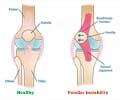Report says soccer-specific exercise program that includes individual instruction of athletes appears to reduce the risk of knee injuries in young female players
A report in the January 11 issue of Archives of Internal Medicine, one of the JAMA/Archives journals, says that a soccer-specific exercise program that includes individual instruction of athletes appears to reduce the risk of knee injuries in young female players.
Soccer is a dominant cause of sports-related injuries in part because of its increasing popularity, according to background information in the article. Between 2000 and 2006, the number of female soccer players around the world increased by 19 percent, to 26 million. "The most frequent and severe type of injury among soccer players is to the legs, especially the knees. The anterior cruciate ligament (ACL) injury incidence is highest among young athletes," the authors write. "Knee injuries, and especially ACL ruptures, may have long-term consequences, including a long absence from soccer, incomplete recovery and secondary osteoarthritis of the knee."Ashkan Kiani, M.D., of Uppsala Primary Care, Uppsala County Council, Sweden, and colleagues assessed an intervention program specifically designed to reduce the risk of soccer-related knee injuries among 1,506 13- to 19-year-old Swedish female players. The program featured strengthening exercises designed to achieve an improved motion pattern, reducing strain on the knee joint. The training sessions were integrated into the regular soccer practices and required no additional equipment. In addition, players, parents and team leaders attended a seminar to raise awareness of injury risk.
During 2007, 777 girls on 48 teams participated in the program and 729 players on 49 teams served as controls. Three knee injuries, including one non-contact injury (not involving another player), occurred among players participating in the program, compared with 13 knee injuries and 10 non-contact injuries among girls in the control group. Therefore, the program was associated with a 77 percent reduction in the incidence of knee injuries and a 90 percent reduction in the incidence of non-contact knee injuries.
"The rate of injury was not only lower among teams participating in the preventive program but the injuries that did occur were also less severe," the authors write. All three injuries in the intervention group were categorized as major, but all three players regained full activity within six months. Among the control participants, most injuries were severe, and only four of the 13 regained full activity within six months.
Coaches reported their teams' adherence to the program at two time periods, after the preseason training period and after the competitive season. Of the 48 teams participating in the intervention, 45 (94 percent) reported a high adherence of at least 75 percent. "The high compliance rate in this study suggests that the program is easy to implement and incorporate into regular soccer practice," the authors conclude.(Arch Intern Med. 2010;170[1]:43-49. Available pre-embargo to the media at www.jamamedia.org.)
Editor's Note: This study was supported by Folksam, the Uppsala County Council, the Swedish Athletic Institute of Education in Uppland, the Uppland Football Association, the Dalarna Football Association and the Department of Research and Development, Uppsala Primary Care, Uppsala County Council. Please see the article for additional information, including other authors, author contributions and affiliations, financial disclosures, funding and support, etc.
Advertisement
Editorial: Findings Score a Goal for Prevention
"Physical activity represents a key strategy for stemming the epidemics of obesity and type 2 diabetes mellitus," write Mitchell H. Katz, M.D., of the San Francisco Department of Public Health, and Rita F. Redberg, M.D., M.Sc., of the University of California, San Francisco, and editor of the Archives, in an accompanying editorial. "Team sports are a particularly good way to promote activity and its health benefits because teams create an environment that is fun and sociable."
Advertisement
"The use of an interdisciplinary team to develop an intervention (with parents and coaches promoting healthful behaviors and players performing exercises that stretch and strengthen muscles while promoting balance) is likely to be successful not only in preventing other soccer-related injuries but also in preventing injuries in other competitive sports such as football, basketball and tennis," they write. "While improvements in both diagnosis and treatment for sports injuries have been impressive in recent years, Kiani and co-authors present a simple, inexpensive routine to avoid injuries in the first place."(Arch Intern Med. 2010;170[1]:10-11. Available pre-embargo to the media at www.jamamedia.org.)
Editor's Note: Please see the article for additional information, including other author contributions and affiliations, financial disclosures, funding and support, etc.
Source-Eurekalert
RAS















